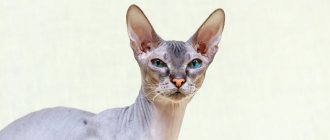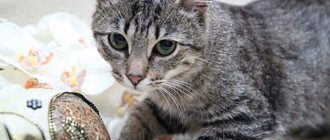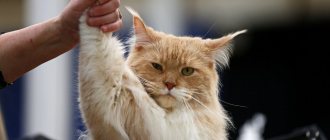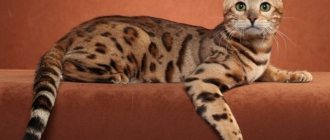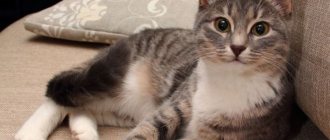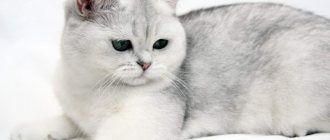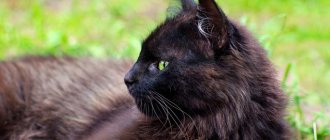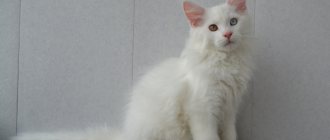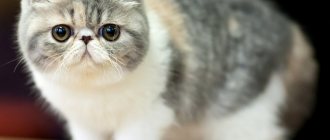History of the breed
The Don and Canadian Sphynx breeds were the result of natural mutational changes, and the Peterbald is the fruit of the experiments of St. Petersburg breeders, whose work was crowned with success in 1994. The idea of creating a hairless cat with a sophisticated appearance belonged to Olga Mironova, a famous felinologist in St. Petersburg. The founders of the breed are considered to be four kittens from a litter obtained from the mating of a Don Sphynx and an Oriental cat.
Already in 1996, the breed was recognized by the SFF organization with the abbreviation PBD. A year later, the breed was recognized by TICA, and in 2003 by WCF. Other abbreviations for the breed are PTB, PD, PSX. Work on the further development of the breed is aimed at achieving maximum compliance with the exquisite Oriental Siamese type.
Where to buy Peterbald, price
St. Petersburg sphinxes currently cannot boast of frantic demand. In Europe and America, the breed has not yet found wide distribution; the handsome Neva is just gaining popularity.
There are not many nurseries in Russia. The cost of kittens is from 5,000 to 15,000 rubles. These will be babies who do not meet the standards and established exhibition norms. But show Peterbald kittens, which are more difficult to acquire than regular ones, will cost more - up to 40,000 rubles.
Little Peterbalds can be taken home when they reach three months of age. If you do this earlier, the baby will have a hard time experiencing separation from his mother, which will immediately affect his development and health.
Description of Peterbalds
When describing the Peterbald's appearance, the first words that come to mind are grace and elegance. These animals are most similar to oriental cats, but differ from them in the complete or partial absence of vegetation.
Table: breed standard (TICA)
| Parameter | Description |
| Head | It resembles an elongated, inverted triangle - with vertices at the tips of the ears and a noticeable narrowing towards the chin. |
| Muzzle | Resembles a smooth wedge. The cheekbones are high, the profile is straight. There is a noticeable transition angle between the nose and forehead. The whisker pads are small, but visually identifiable. Mustaches - if present, should be curly. |
| Eyes | Medium size, almond shaped. They don’t perform and they don’t fail. The color can be blue or green. |
| Ears | Large in size, tapering to the tips. Slightly spread apart. |
| Torso | Elongated, graceful. The width of the shoulders and hips is the same. The muscles are well developed. |
| Legs | Long, with strong muscles. The hind ones are slightly longer than the front ones. |
| Paws | Medium size, oval shape. The fingers are movable, the pads do not protrude. |
| Tail | Long, thin, flexible. |
| Wool | It has an important feature: its type changes several times during the process of growing up. May be completely absent or of varying lengths. |
Peculiarities of skin and color
The skin of Peterbalds resembles human skin in some ways - it is also sensitive to ultraviolet radiation, can sweat and sunbathe. The skin of so-called rubber cats, that is, completely hairless cats, has increased sensitivity. Treatment with baby oil can protect it from drying out and damage.
An additional, natural protection of hairless cats from negative external influences is the secretion of a special brown lubricant, accumulations of which can be observed in the claw area and in the ears.
In the complete absence of vegetation, the color appears on the skin like a tattoo. This pigmentation is called “color shadow”, which makes it difficult to draw a clear line between the options for primary and light shades.
The black Peterbald looks unusual, but this color is only possible if there is fur.
The range of Peterbald colors is quite wide. The most popular include:
- cream;
- black;
- tortoiseshell;
- chocolate;
- blue;
- color point;
- particolor - a combination of any color with white.
Varieties of Peterbalds by skin type
Within the Peterbald breed there are several transitional variations of the skin:
- Naked. The fur is completely absent, and the skin secretes a special secretion, which is why it looks like rubber and, when stroked, stretches behind the palm.
- Flock. There is barely tangible fluff, the length of which does not exceed 2 mm.
- Velours. At an early age, soft fur is present on the entire body, and the hair is longer on the points. With age, hairs usually remain only on the limbs in the form of “socks” or “socks”.
- Brush. The cub is covered with fur, which can be long or short, as well as wavy. As you get older, bald patches may form on your back and neck.
- Brush point. Vegetation covers the body in the so-called brush type. With age, hairs remain only on the points.
The litter may contain cubs with straight fur that does not fall out over time. Such individuals can participate in breeding, but are not allowed to exhibit.
If a Peterbald is purchased for the purpose of future participation in exhibitions, it is better to choose a cub with a completely hairless coat or a flocked type. Such individuals are considered the best representatives of the breed.
Character
Peterbalds are friendly and very attached to people. These are unusually affectionate and playful animals. They are absolutely not aggressive - even if handled roughly, they do not release their claws, but simply leave. They easily get along with other pets living at home.
The sociability and need for attention of St. Petersburg sphinxes can be compared with that of a dog - they constantly need the presence of a person and do not like loneliness. The long absence of the owner is a tragedy for them. Peterbalds are active and have a high level of intelligence. They do not need training - Peterbalds have good manners by nature. They are easy to teach a variety of tricks - sit, lie down, give a voice.
Features of sphinx brushes
The process of shedding fur with age is almost unpredictable . Moreover, the coat changes (cats undress and dress) depending on the ambient temperature and the change of seasons, on hormonal levels (pregnancy, estrus) and even on a change in the type of food.
Brush Sphynx cats do not meet the standard characteristics of hairlessness, but they are not considered a defect. They take part in exhibitions and are evaluated by experts, but they are never awarded champion titles. However, such individuals are extremely valuable in breeding, since they are much more fertile than their hairless fellow tribesmen.
Two completely naked sphinxes often give birth to weak and sick offspring with congenital physical defects. Brushes are more caring and responsible parents, unlike baldheads, who sometimes refuse to acknowledge their offspring.
Only hairless cats receive titles at shows.
Brush varieties are healthier, have a strong bone structure and a well-shaped head with a firm, pronounced chin. Such kittens are usually larger and more viable, develop faster and reach sexual maturity earlier, while their hairless counterparts grow more slowly, often get sick, and the mortality rate among them is quite high. Adult hairless individuals are sterile.
Felinologists have noticed the influence of the type of coat on the phenotype of the animal. The sparser and thinner the coat (balder), the more clearly the phenotypic features of the breed stand out (shortened muzzle, wide, emphasized cheekbones, widely spaced eyes).
Photo gallery: popular colors of Peterbalds
Hairless Peterbalds are cream-colored and very light, with pale pink skin. Flocked and brushed Peterbalds look like white
The skin of black Peterbalds appears slate gray, sometimes with a dark brown tint.
The color of the coat of hairless Peterbalds is light brown, while that of flocked Peterbalds is rich chocolate.
Blue St. Petersburg Sphynxes have an even light-deep color with a silvery tint
Color-point Peterbalds always have bright blue eyes.
The dark and light areas of the tortoiseshell Peterbald are arranged in the most bizarre way
Peterbald particolor is a combination of any color with white
How to care
St. Petersburg Sphynxes require careful care. Due to the lack of wool, animals are constantly cold. They can quickly catch a cold and are often exposed to respiratory diseases. The room must be maintained at an optimal temperature, at least +22.
Peterbalds sweat a lot, so you need to wipe them with a cloth and bathe them more often using special shampoos. Sphinxes are not afraid of water and can even swim.
The skin secretes a kind of secretion that has a protective effect. But after it hardens, dark spots remain on the skin. It is strictly forbidden to wash off discharge with shampoos. This grease is removed with cotton swabs and soap.
Peterbalds have nothing to comb, but this does not make grooming any easier. Drafts should be excluded and the animal should not be allowed to stay in the sun for a long time. The skin will not only tan, but also get burned.
In cold weather, it is better to dress cats in overalls.
Features of choosing a Peterbald kitten
It is best to purchase not only a Peterbald, but any purebred kitten in a nursery - only in this case can you count on the animal being purebred and healthy. You can find a suitable nursery and find out about its reputation via the Internet.
Having chosen a nursery, you need to observe the kitten in its familiar environment. This way you can visually assess the physical condition of the animal and select a pet of a suitable temperament. A healthy cub should not cough or sneeze or itch. You also need to make sure that your eyes and ears are clean and that your gums are not inflamed.
The skin should be soft and pleasant to the touch - without dry areas or red spots. There should be no hernias on the tummy, and no swelling around the nipples. A healthy, small Peterbald should look like a bun - its tummy should be round and full. He should be playful and active, easy to make contact with.
No competent breeder will give away a kitten before three months of age. It is by this time that the animal acquires all the necessary skills and is ready for independent life.
The purchase of a pet must be documented in a sales contract. Other mandatory documents that the breeder must submit along with the animal are a birth certificate, pedigree and veterinary passport.
It is a mistaken belief that hairless cats do not cause allergies. The protein that causes the undesirable reaction is found not only in the animal’s fur, but also in the animal’s saliva and urine. Peterbalds and other sphinxes can only be called less allergenic representatives of cats.
Coat Variations
Only the Peterbald has such a variety of skin and coat varieties. In one litter, kittens of absolutely all types can be born:
- Brush. They are born with little fur. As they grow older, the fur disappears in some areas, while the rest are evenly covered with hair.
- Brush point. At birth, the kitten is covered with thicker hair, the muzzle and tail are completely pubescent. In an adult animal, fur remains on some parts of the head, paws and tail. The rest of the body is covered with a delicate short flock.
- Velours. At birth, a kitten has long hair on its face, paws, and tail. Later, very short hair remains in these areas, the rest of the body is naked.
- Flock. The newborn has no eyebrows or mustache. Light fur all over the body can be determined only by touch, not visually visible, the hair length is up to two millimeters. An adult cat is completely hairless; there may be some sensation of fur on the hands.
- Straight-haired. Full coat, characteristic of the Oriental, there is no hairless gene. In terms of body structure and habits - Peterbald.
- Rubber (bald-born). It is very rare that babies are born completely bald, both visually and to the touch. In an adult cat by the age of two, the skin feels like rubber, stretches well, the skin is velvety and soft to the touch.
It is not always possible to determine the type of integument immediately at birth. More often this can be done in five to seven days.
The type indicator can be the period of eye opening. The Peterbald has a special structure of the lacrimal glands, which allows rubber sphinxes to be born with open eyes without the threat of loss of vision. Brush, point brush and velor open their eyes on the fifth day after birth.
The most valued and recommended for show class are bald and flock-Peterbalds, as they are animals with the most pronounced characteristics of the breed.
Features of caring for Peterbalds
The unusual skin of Peterbalds requires compliance with certain rules of care. Red-brown discharge that appears on the animal's skin can stain furniture and light-colored clothing. To prevent this, you need to wipe your pet with wet wipes. Peterbalds should be bathed no more than 2 times a month. Tar soap is ideal for washing. After the procedure, the pet should be carefully dried with a towel and wrapped warmly. You should know that there is no need to get carried away with water procedures - too frequent washing removes the protective lubricant and leads to dryness.
The presence of discharge in the corners of the eyes in Peterbalds is considered normal, provided that they are transparent and do not have a yellowish-green tint. Cleaning the area daily with a cotton pad soaked in water may solve the problem.
Careful and regular inspection is required behind the ears and the area between the toes. They should also be cleaned carefully using cotton swabs. Secretions mixed with dirt may accumulate under overgrown claws, so they should be cut at least once a week. However, by accustoming your pet to a scratching post, you can save yourself from this procedure.
Walking hairless animals in the cold season is not recommended. In the mid-season, you should use a carrier or “dress up” your pet in overalls. In summer, you can take walks every day, you just need to make sure that your pet is not exposed to excessive ultraviolet radiation.
In cool weather, Peterbalds must be walked in special clothing.
Nutrition
Peterbalds have an excellent appetite. They are not picky and enjoy eating even plant foods. It is necessary to observe the frequency of feeding - no more than 4 times a day. The daily menu must be balanced. The Peterbald's diet requires the presence of raw fish, meat - beef and lamb, boiled liver, fermented milk food, and fresh plant products.
Maintenance and care
Caring for St. Petersburg Sphynxes does not cause any particular difficulties or hassle. The absence of hair is the main advantage that allows cats not to be combed. But still, the owner will have certain responsibilities:
- It is necessary to wipe your eyes every day to prevent mucus from accumulating.
- Clean your teeth and ears periodically.
- Trim your claws.
Many owners are divided on bathing a St. Petersburg cat. The pet's skin is naturally coated with a special lubricant that performs a protective function. If you bathe too often, this plaque will be washed off, which will lead to stress in the animal. But large accumulations of grease still need to be removed.
Some Sphynx owners use a regular sponge or wet wipe. Other owners bathe cats with a special shampoo, and then wipe the pet dry with a soft towel. It must be remembered that under prolonged exposure to solar ultraviolet radiation, the skin of Peterbalds will certainly burn, but a weak, moderate tan will only bring benefits.
To prevent the skin from drying out and chapping, you should use baby creams.
The lack of hair causes the St. Petersburg Sphynx to have a fast metabolism, so they always have an excellent appetite. Dry species should be used as the main feed. But the main thing is to ensure that the food is completely balanced and contains all the necessary microelements and vitamins. You can determine the correct choice of diet using a protective lubricant. If there is too much of it, it means something is wrong.
Mating of Peterbalds
The main thing to consider before breeding Peterbalds is that you cannot breed completely hairless cats with cats of the same type. A very common result of such a union can be the appearance of offspring with serious pathologies. It is optimal that one of the parents is bald and the other has brush or velor fur.
A female cat must be in two heats before she can go on a “date” with a male cat. The ideal time for mating is approximately one and a half years old. A sign of the onset of heat is the animal's excessive affection - the cat begins to rub against everything, and when you pet it, it purrs, arches its back and trembles. The cat will help you understand whether the mating time has been chosen correctly - he will either immediately show readiness for affection, filling the room with a loud meow, or, if the kitty arrived early, he may leave altogether. The result can only be achieved after several matings.
All existing standards allow crossing Peterbalds with Orientals and Siamese breeds; mating with Balinese and Javanese is also allowed.
If both parents are Peterbalds, then there is a high probability of completely hairless or flocked kittens appearing in the litter. When mating the St. Petersburg Sphynx and Oriental cats, cubs with skin type flock, brush or straight-haired may appear.
Conclusions about the Peterbald breed
Before getting a St. Petersburg Sphynx, you should weigh the pros and cons:
Usually the oriental pet becomes everyone's favorite and a good friend for children and other animals.
Castration and sterilization
Some owners cannot decide to spay or neuter their Peterbald pet. They cannot imagine him on the operating table, they think that he will be in pain, and after the veterinarian’s intervention there may be health problems. In fact, castration of an animal is considered one of the safest and most popular operations. Thanks to her, owners get rid of the need to endure unpleasant moments associated with the animal’s sexual life and look for somewhere to place their offspring, and their pets become calmer and more affectionate. In addition, after surgery, the risk of developing some serious pathologies in animals is reduced.
Both castration and sterilization are surgical procedures whose purpose is to disrupt the reproductive function of an animal. Sterilization can be carried out in several ways. Almost all of them, while depriving the animal of the ability to reproduce, do not affect hormonal levels in any way. In other words, the owner will be spared the need to accommodate unwanted offspring, but the cat will still experience sexual desire. Therefore, the castration procedure is considered more popular.
The optimal age for castration is from 6 to 14 months. Surgery too early may contribute to growth retardation. Castration of both male and female cats takes very little time - from 5 to 15 minutes. The pet is under anesthesia for a short time, and blood loss can be called minimal. According to statistics, complications after castration occur in only 0.05% of animals.
Temperament of the St. Petersburg Sphynx
For those people who are thinking about purchasing a Neva Sphynx, it would be useful to understand the features of this breed:
- Experts often call this animal a “cat-dog”, since its habits are more reminiscent of a dog’s - they follow their owner with their “tail”, are able to learn the simplest commands, are smart and amenable to training.
- They are loving towards all family members and do not tolerate loneliness well.
- They are affectionate, capable of waiting for the owner all day, sitting at the door and joyfully rushing towards him. They know their name well and respond.
- Talkative too much. If you love a calm, measured life, then it is unlikely to be possible with the St. Petersburg Sphynx. The cat almost always “talks”, expressing all his feelings and emotions.
- Since the Peterbald cannot be left alone at all, you will have to find him a playmate, and he will get along with absolutely any pet.
- They are very playful all their lives and are happy to join children in noisy fun.
- Smart and cunning. They easily learn to open everything - bags, drawers, doors to the room, and even the refrigerator.
- They are unusually voracious, which is due to their physiological characteristics.
- Clean, excellent hunters.
When choosing this pet, you need to remember that you won’t be bored with it and balance your habits and inclinations with the cat’s temperament.
Peterbald diseases
With proper and regular care, timely vaccination and deworming, these animals do not experience any special health problems. Due to the characteristics of the skin, the Peterbald may develop an allergic rash, which can be combated with the help of a regular anti-acne lotion, Salicylic ointment or Zenerite.
Hairless animals should not be overcooled to avoid colds and respiratory problems. That is why many owners buy warm clothes for their pets and allow them to sleep under the blanket with them.
Peterbalds love to climb into bed and sleep next to a person.
In Peterbalds whose skin has a tortoiseshell, blue and cream color, gum hyperplasia can be observed. Surgery will help stop the development of pathology. Regular care will help to avoid inflammation of the eyes and ears.
The most dangerous pathology of Peterbalds is the underdevelopment of the thymus, the gland responsible for the development of all systems and protective functions of the body. This disease in all cases ends in the death of the animal.
What diseases do Peterbald Sphynxes suffer from?
On average, Peterbalds live 13-15 years.
But the St. Petersburg Sphynx is a representative of an exotic breed, and therefore is susceptible to several genetic diseases:
- The most dangerous disease is congenital underdevelopment of the thymus gland. The organ is responsible for immune defense and development of the body as a whole. Because of this disease, pets die while still kittens.
- Some blue and tortoiseshell Sphynx cats suffer from gum hyperplasia (tissue growth).
Peterbalds are characterized by sensitive skin diseases. In summer, veterinarians advise using sunscreen. And for dryness, use baby oil.
Reviews
My family and I are the happy owners of a wonderful cat of the St. Petersburg Sphynx (or Peterbald) breed. We bought her about 9 years ago at a cat show at the age of 4 months. Ours is naked velor (flock). When I was a little girl, I didn’t even have a mustache, but now I have a few :). I have always wanted such a breed, I was especially attracted by the character and intelligence of cats, they are affectionate, smart, affectionate and love small children. That's how it turned out. This is the most tender animal in the world. You can’t imagine how much she loves us all. If someone is not at home for several hours in a row, when he meets you, he rejoices, caresses you endlessly, and follows you on your heels. When a child was born in the family, they were afraid that he might scratch or jump on the little one, so at first they kept the bedroom where the child slept closed at night. She, the poor thing, was crying under the door, my heart was breaking, but the child comes first, so what. Then they slowly began to let her in, and she never even scratched him, although he tore her as he wanted. She endured everything stoically if we didn’t intervene quickly. We, adults, could be bitten and scratched in play, but not little ones. When my husband and I went on vacation, she stayed with my mother and child in the apartment, she was very bored, ate, drank and slept, did not approach my mother to caress her, it was obvious that she was sad. When we arrived, everything returned to normal :). If you decide to get a Sphynx, be sure to take care of him, that is, for him, all these hugs and strokes are as important as food and water, seriously. Without them, the animal becomes sad and may get sick.
Moso
https://spasibovsem.ru/responses/samaya-laskovaya-koshka.html
A couple of years ago, my husband gave me a Peterbald cat. My joy knew no bounds, a small white creature with huge ears and huge blue eyes. On the very first night, priorities were set, the husband was kicked out of bed for 4 days, but after he started communicating with her he was accepted back, now the three of us sleep together) Peterbalds are a magical breed. Our girl is smart, very talkative, bright, playful, and sociable. She loves it when guests come to us, she immediately brings toys). Very patient in dealing with children, she will endure all the squeezing and manifestations of boundless love from the kids. Great breed for a family!!!
encore
https://irecommend.ru/content/lyubimyi-detenysh-foto-koshki
Firstly, of the sphinxes, the St. Petersburg sphinx is the most beautiful, graceful, a godsend for photographers. Very sociable and talkative, for those who love quiet animals - this can be considered a disadvantage. Therefore, this breed is for children, because it is very playful and for lonely people who lack communication. The most important thing is education - as you teach and show prohibitions, that’s how they will be. If you give in at least once, then you won’t be able to wean him off, for example, to climb on a table. My sphinxes do not climb, even if there is raw meat there. From a hygienic point of view, this is the most advantageous breed, because you can wash yourself as often as you do. They sweat when it's hot, the skin is oily, but this is not a problem - wipe it with a damp napkin and that's it. In terms of character and intelligence, they are between a dog and a cat - you can calmly teach them to carry out basic commands. These breeds practically do not mark; my adult cat does not know how to mark. The cat goes to the toilet, there are no problems with the trays, it all depends on how you train it. The skin is very hot, it is good to treat radiculitis and not only - they find the sore spots themselves and sit down.
AllahK
https://irecommend.ru/content/peterburgskii-sfinks-zamechatelnaya-poroda
Character
Usually, when two breeds are crossed, the character tends to be dominated by the tendencies of one of the ancestors. In Peterbalds, the genes of the Oriental cat prevail.
Cats of this breed are good-natured and quite playful, sociable, with an unusually lively mind. They are very loyal to their owners and love to communicate with them. They purr melodiously when they are tugged behind the ear.
Peterbalds do not tolerate loneliness well. They just need to be the center of attention and feel like an object of love.
Aggressive behavior and rancor are not typical for representatives of this breed. There are, of course, certain situations when, having played too hard, they can accidentally scratch you. But children are never touched. The Peterbald easily gets along with other pets.
Cats of this breed have high intelligence. It is easy to train, and it will not be difficult to accustom it to a tray and a scratching post.
The St. Petersburg sphinxes have a unique feature: they have the ability to heal and relieve stress.
Cats of this breed are very clean. The manner of behavior will not cause any trouble to the owners. But the eastern mystery does not prevent them from always checking something, looking for something, opening drawers and climbing on tall pieces of furniture.
By the way, he is very chatty and will not just listen, but will express his cat’s opinion. Cats of this breed do not refuse to walk, but their naked bodies should be protected with special clothing. You should not let go of the leash, otherwise it will be difficult to remove it from a tall tree.
Skin types
Kittens are born of several types. The Peterbald breed is characterized by:
- Brush. At the moment of birth, the kitten's body is completely covered with Rex curly hair, both long and short. As you age, bald spots may appear.
- Brush point. Kittens are born covered with hair, like brushes, but with age it remains on the legs, tail, ears and face. In general, the body of such a Peterbald can be bald and covered with soft fluff.
- Velours. Little Peterbald will be born covered with velvety fur, with it being slightly longer on the paws, tail and muzzle. Subsequently, this is where this cover remains, and the body becomes bald.
- Flock. These kittens are almost naked. Wool can only be felt by touch. With age, it remains in limited areas, almost invisible visually. They do not have mustaches or eyebrows.
- Varietta, or straight-haired St. Petersburg Sphynx. Retaining all the characteristics of the breed, such kittens are born with the usual short coat, in addition, they have a mustache and eyebrows.
Features of the skin
Peterbald's skin has the same properties as humans: it sweats, tans, becomes covered in rashes and even pimples during puberty. It is very difficult to determine what color a cat has; this can only be done in the first days after the birth of kittens, while they still have the rudiments of fur. The color appears simply on the body.
In addition, a distinctive feature of the Peterbald is a sticky secretion that is secreted by the skin glands in the area of the ears, claw sinuses and between the toes. This secretion is a lubricant, it is often dark, brown-brown in color and serves to protect against environmental conditions. It stands out most intensely in completely hairless cats, and in cats that have retained their fur, it is not so noticeable.
